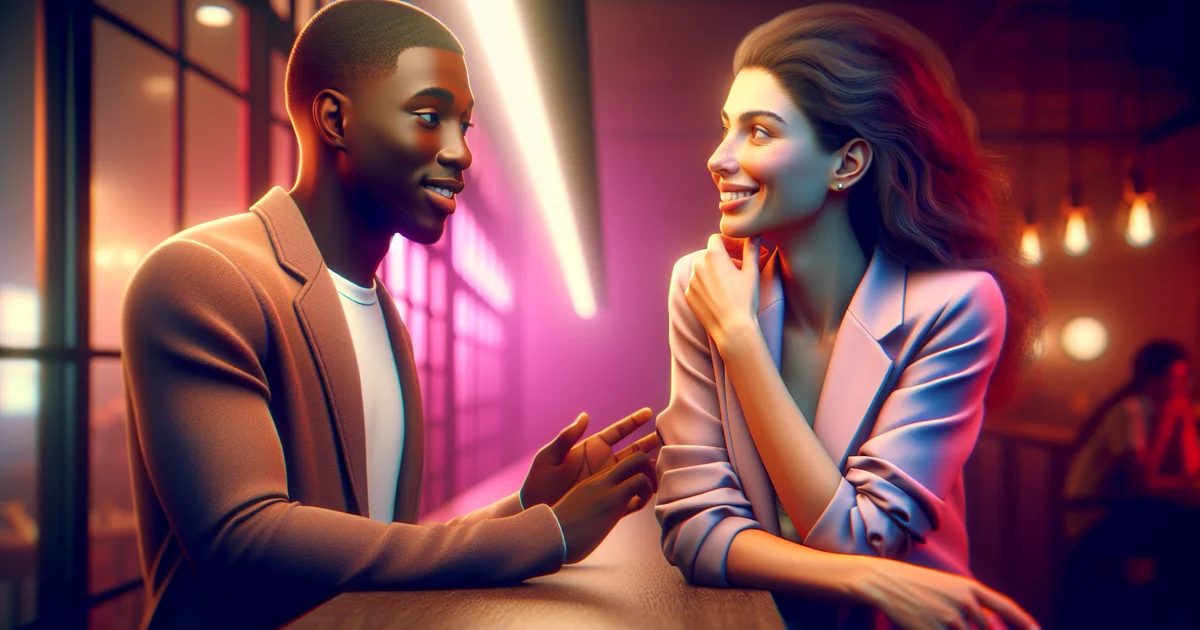
The Silent Language of Attraction
Before words are exchanged, our bodies communicate volumes. Understanding these signals can help you gauge interest and choose the right moment to approach. Whether you're at a bar, coffee shop, or on a first date, reading body language is a crucial skill.
But here's the important caveat: body language is a guide, not a guarantee. Cultural differences, neurodiversity, and individual personality all affect how people express interest. Use these signs as hints, not absolute rules.
Positive Signs to Look For
Eye Contact: The Universal Signal
What to look for:
- Sustained eye contact: Looking at you repeatedly or holding your gaze for 2-3 seconds
- The "look away and look back": They glance away, then quickly look back to see if you're still looking
- Dilated pupils: A biological response to attraction (though lighting also affects this)
What it means: Interest, curiosity, invitation to approach
Mirroring: The Unconscious Compliment
What to look for:
- Unconsciously copying your posture or gestures
- Matching your energy level (you lean in, they lean in)
- Adopting similar body positions
What it means: Subconscious rapport and comfort with you
Open Body Language
What to look for:
- Arms uncrossed, body facing toward you
- Leaning in when talking to you
- Removing barriers (moving a purse, phone, or drink to the side)
- Feet pointing toward you (people point their feet toward what interests them)
What it means: Openness, receptiveness, engagement
The Duchenne Smile
What to look for:
- A smile that reaches the eyes (crow's feet appear)
- Genuine laugh at your jokes (even if they're not that funny)
- Relaxed facial expression
What it means: Real enjoyment of your company, not just politeness
Physical Proximity
What to look for:
- Moving closer when talking to you
- Finding excuses to touch (light arm touch, playful nudge)
- Not creating distance when you move closer
What it means: Comfort and desire for closeness
Red Flags to Respect
Just as important as recognizing interest is respecting disinterest. Here are the signs to back off:
Avoiding Eye Contact
- Looking away frequently or never making eye contact
- Scanning the room as if looking for an exit or another person
- Checking phone repeatedly
What it means: Discomfort, disinterest, wanting to leave
Closed-Off Body Language
- Crossed arms or legs
- Body angled away from you
- Creating physical distance (stepping back, leaning away)
- Barriers (holding purse/drink between you)
What it means: Defensiveness, discomfort, lack of interest
Short, Closed Responses
- One-word answers
- Not asking questions back
- Looking for conversation exits ("I should get going," "My friend is waiting")
What it means: They're not interested in continuing the conversation
The Polite Smile
- Tight-lipped smile that doesn't reach the eyes
- Forced laughter at your jokes
- "Busy" signals (emphasizing they have to get back to work/friends)
What it means: Politeness, not interest
Context Matters
Body language doesn't exist in a vacuum. Consider the context:
Cultural Differences
- Some cultures use less eye contact as a sign of respect
- Personal space preferences vary widely
- Physical touch norms differ across cultures
Neurodiversity
- Autistic individuals may avoid eye contact even when interested
- Some people have a naturally reserved body language
- Anxiety can mimic disinterest (fidgeting, looking away)
Personality Types
- Introverts may show interest more subtly than extroverts
- Shy people might be interested but appear closed-off
- Confident people might seem interested in everyone (it's their baseline)
How to Use This Information
Step 1: Look for Clusters
Don't rely on one signal. Look for 3-4 positive signs together:
- Sustained eye contact + leaning in + genuine smile + open posture = Strong interest
Step 2: Test the Waters
If you're getting positive signals, make a small move and gauge the reaction:
- Move slightly closer → Do they maintain proximity or step back?
- Ask a question → Do they engage or give short answers?
- Use a conversation starter → Do they light up or seem bored?
Step 3: Respect the Red Flags
If you're seeing closed-off signals, don't push it:
- Thank them for their time
- Smile and move on gracefully
- Don't take it personally—timing and circumstances matter
The Takeaway
Reading body language is a skill that improves with practice and observation. Pay attention to clusters of signals, respect cultural and individual differences, and always honor clear signs of disinterest.
When you see genuine interest—sustained eye contact, open posture, genuine smiles—that's your green light to approach with confidence. Try a smooth pickup line, a funny opener, or just a genuine "Hi, I'm [name]."
And remember: body language can invite the conversation, but it's your authenticity, respect, and social intelligence that will determine where it goes from there.
Ready to make your move? Check out our collection of pickup lines for every situation.
Put Your Knowledge to Use
Browse our collection of pickup lines and start making connections
Explore Pickup Lines💬